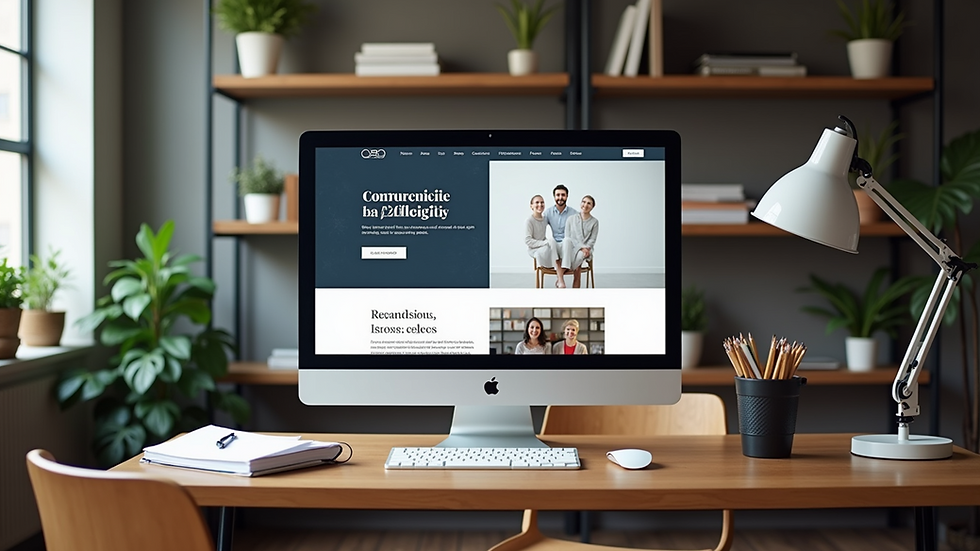Transform Your Online Presence with Custom Web Design
- Donald W. Carroll
- Jul 31
- 4 min read
In today’s digital world, your website is often the first impression customers have of your business. A well-designed website can attract visitors, build trust, and convert leads into loyal customers. Custom web design offers a unique opportunity to create a site that truly reflects your brand and meets your specific needs. This post will explore how custom web design can transform your online presence and provide practical tips to help you get started.
Why Custom Web Design Matters
Custom web design is more than just aesthetics. It’s about creating a website tailored to your business goals, audience, and brand identity. Unlike template-based designs, custom websites offer flexibility, scalability, and uniqueness.
Brand Consistency: Custom design ensures your website aligns perfectly with your brand colors, fonts, and messaging.
Better User Experience: Tailored navigation and layout improve usability, keeping visitors engaged longer.
SEO Advantages: Custom sites can be optimized for search engines more effectively, improving your visibility.
Competitive Edge: Stand out from competitors who use generic templates.
For example, a local bakery might want a warm, inviting design with easy online ordering, while a tech startup may prefer a sleek, modern look with interactive features. Custom web design allows these specific needs to be met precisely.

Essential Custom Web Design Tips for Success
Creating a custom website can seem overwhelming, but focusing on key design principles can make the process smoother and more effective.
1. Prioritize Mobile Responsiveness
With over half of web traffic coming from mobile devices, your site must look and function well on smartphones and tablets. Responsive design adapts your layout to different screen sizes, ensuring a seamless experience.
2. Keep Navigation Simple
Visitors should find what they need quickly. Use clear menus, logical categories, and a consistent structure. Avoid clutter and too many options.
3. Use High-Quality Visuals
Images and graphics should be sharp and relevant. Avoid stock photos that feel generic. Custom illustrations or professional photography can enhance your brand story.
4. Optimize Loading Speed
Slow websites frustrate users and hurt SEO rankings. Compress images, minimize code, and use reliable hosting to keep your site fast.
5. Incorporate Clear Calls to Action (CTAs)
Guide visitors toward desired actions like signing up, purchasing, or contacting you. Use contrasting colors and concise text for CTAs.
6. Focus on Accessibility
Ensure your website is usable by people with disabilities. Use proper color contrast, alt text for images, and keyboard-friendly navigation.
By applying these custom web design tips, you can create a website that not only looks great but also performs well and meets your business objectives.

How to Design a Website for a Small Business?
Small businesses often have limited budgets and resources, making custom web design a strategic investment. Here’s a step-by-step guide to designing a website that fits your small business needs:
Step 1: Define Your Goals
Identify what you want your website to achieve. Is it to generate leads, sell products, provide information, or build a community? Clear goals guide design decisions.
Step 2: Understand Your Audience
Research your target customers’ preferences, behaviors, and pain points. This helps tailor content and design to their expectations.
Step 3: Choose the Right Platform
Select a content management system (CMS) that suits your technical skills and business needs. Popular options include WordPress, Shopify, and Wix.
Step 4: Plan Your Content
Create a sitemap outlining all pages and their hierarchy. Develop engaging, SEO-friendly content that speaks directly to your audience.
Step 5: Design Wireframes and Mockups
Sketch basic layouts to visualize the structure. Then create detailed mockups showing colors, fonts, and images.
Step 6: Develop and Test
Build the website using clean code and test it across devices and browsers. Fix any bugs and optimize performance.
Step 7: Launch and Promote
Publish your site and promote it through social media, email marketing, and local advertising.
For small businesses looking for expert help, partnering with professionals specializing in web design small businesses can save time and ensure a polished final product.

Benefits of Investing in Custom Web Design
Investing in custom web design offers several long-term benefits that can significantly impact your business growth.
Unique Brand Identity: A custom site reflects your brand’s personality and values, making it memorable.
Improved Conversion Rates: Tailored user journeys and CTAs increase the likelihood of visitors taking action.
Scalability: Custom websites can grow with your business, adding new features and pages as needed.
Better SEO Performance: Custom coding and structure allow for more effective search engine optimization.
Enhanced Security: Custom sites can implement stronger security measures to protect your data and customers.
For example, a custom e-commerce site can integrate specific payment gateways, inventory management, and customer support tools that off-the-shelf solutions may not offer.
Tips for Maintaining Your Custom Website
Building your website is just the beginning. Regular maintenance ensures it stays secure, fast, and relevant.
Update Content Regularly: Keep your blog, products, and information fresh to engage visitors and improve SEO.
Monitor Performance: Use tools like Google Analytics to track visitor behavior and identify areas for improvement.
Backup Your Site: Regular backups protect against data loss.
Check for Broken Links: Fix or remove links that no longer work to maintain user experience.
Update Software and Plugins: Keep your CMS and plugins up to date to avoid security vulnerabilities.
By following these maintenance tips, your custom website will continue to serve your business effectively over time.
Custom web design is a powerful tool to elevate your online presence. By focusing on your unique needs and applying proven design principles, you can create a website that attracts, engages, and converts visitors. Whether you’re a small business or a growing enterprise, investing in a custom website is an investment in your future success.





Comentários